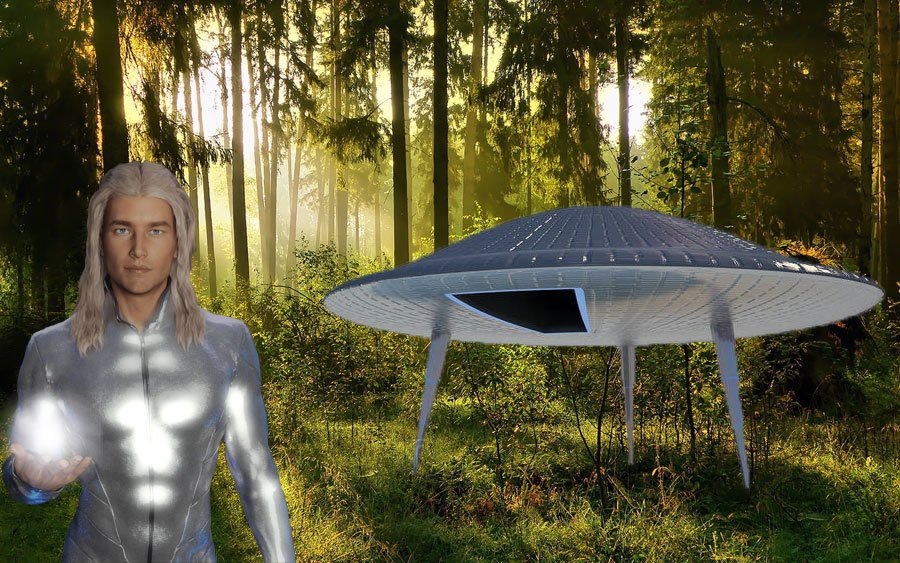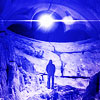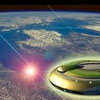Zret And The Norcans
 by Timothy Good
by Timothy Good
‘Oh help me, help me!’ It was June 1920, and 16-year-old Albert Coe was on a canoeing vacation in Ontario with his companion Rod. Alone at the time, Coe heard the muffled cry while clambering to the top of an outcropping of rocks in remote and rough terrain on the Mattawa River. Looking around, Coe could see no one, so he let out a yell. Slightly to his right and ahead came an answer. ‘Oh help me, I’m down here.’
‘I still couldn’t see anyone,’ said Coe, ‘and had walked about 25 feet in the direction of the voice when I came to a five-foot-wide cleft in the base rock that ran diagonally toward the river. Wedged down this narrowing crevice was a young man with his blond head some two and a half feet from the surface. He only had one arm free, so I reached over and grabbed his wrist, but could not budge him. We always carried a coil of rope and a hunting knife, so I cut down a sapling about 10 or 15 feet long to use as a lever, and working my rope under the pit of his pinned arm, circled it around his back and chest, bringing a loop to ground level, at the same time telling him I would try to pry him out. If I failed, I told him not to worry, for my pal was somewhere on the other side of the river, and between the two of us we would free him.’
Slipping the pole through the loop and using the opposite edge as a fulcrum point, Coe gave a heave and felt the stranger move. Raising the lever end higher he propped it on a tree branch, jumped the crevice and pulled the man out. His legs were so numb that he was unable to stand, and the left hip, knee and shin were badly lacerated. The first thing he asked for was water, so Coe clambered back down the rocks to the river and fetched some in his felt hat. Slitting two of his bandannas, Coe also bathed and dressed the wounds. Then some oddities became apparent:
As I was helping him my curiosity was rising as to the identity of my ‘patient’. I told him of our trip and that I was searching for a way to open water, at the same time noticing he was wearing an odd silver-gray, tight jumper-type garment that had a sheen of silk to it. It had a leathery feeling without a belt or visible fasteners attached, but just under the chest was a small instrument panel. Several of the knobs and dials were broken, from being jammed against the rock in his fall. Being so many miles from any form of civilization, I pointedly asked where he was from, if he was on a canoe trip, also when and what had happened to cause his misfortune.
He said that he was not canoeing, but had a plane parked in a clearing, three or four hundred yards downstream, and had started out early the previous morning to do some fishing. In attempting to jump over the crevice, the loose earth and moss had given way underfoot and he had just about given up all thought of ever getting out alive when he heard some of the stones, loosened in my ascent, bouncing down the rock . . . he decided to cry out and said that my answering yell was like a miracle.
‘Well, planes were very primitive in those days,’ Coe went on, ‘and if you can imagine the side of the mountain, coming down, and all those rocks and branches, how the heck did he manage to land a plane? So I didn’t say anything to him – I was thinking the guy was nuts. I thought maybe he’d banged his head and was having hallucinations.’
The stranger requested Coe’s name and address, expressing his eternal gratitude for having been saved. He asked Coe to look for his small tackle-box and fishing-rod which he had dropped when he fell down the crevice. Coe was unable to find the tackle-box, but he did locate the fishing-rod. ‘The mystery of this strange person deepened within me,’ said Coe, ‘the peculiar outfit, a plane landing in this rocky forest and now a fishing-rod, the likes of which I had never seen.’
The butt was about three-quarters of an inch in diameter and had the same leathery touch as his suit, but bright blue and formed in a slight rounded protuberance just above it. It had a tiny slot in either side and continuance in a slender aluminum shaft. It had no guides or reel, for the fine line came directly out from the inside at its tip, as a fine filament, to which was attached a conventional dry fly. I asked where he had purchased such a rod and the question was partially parried with a reply that his father was a research engineer and it was one of his own design.
By now, the circulation was beginning to return to the stranger’s numbed limbs. Although occasionally grimacing from pain, the man’s overall composure, without apparent reaction to the stress or shock from such a torturous ordeal, was astonishing. An offer to help the man back to his plane was at first declined.
Coe and his companion, Rod, had come up against a lot of logs and other flotsam in the river and were anxious to find passage through or around it. The stranger said that, observed from his aircraft, five to six tough miles lay ahead, though he thought the teenagers could perhaps pull their canoe through some of the shallow, swampy water. ‘He did not want to impose upon me any further and said I had better think of starting back, for he had already been quite a burden,’ explained Coe.
From the condition of his leg I doubted that he could even walk, but made no comment as I helped him up. He took two steps, swayed and grabbed a tree to keep from going down. I threw one arm around his waist, lifted his left arm over my shoulder and insisted again that he accept my aid . . . He finally gave in, but on condition of a promise; asking for my solemn word that I would not divulge to anyone, not even my partner, anything that had taken place today, or what I may see. He then told me that his father had developed a new type plane that was still in an experimental stage and highly secret, but he often helped in the lab when home from school. As sort of a test, his father had permitted him to use the plane for this fishing trip. In the future he would fully explain the reason for his request that I keep my promise.
Agreeing to this request, Coe supported and half-carried the man downstream to his aircraft.
THE CRAFT
In a clearing beside the river, no more than 70 or 80 feet wide, stood the aircraft. Fully expecting it to be some type of conventional plane, Coe was astounded by what he saw.
A round silver disc, about 20 feet in diameter, was standing on three legs in the form of a tripod, without propeller, engine, wings or fuselage. As we approached, I noticed a number of small slots around the rim, and it sloped up to a rounded central dome. I had to duck to walk with him underneath, between the legs, although it was slightly concave and only about four and a half feet from the ground.
He said, ‘Surprised?’ That wasn’t actually the word for it, but I did not press him with questions, realizing he was suffering a great deal of pain. The only thing I was trying to figure was, how the hell does the damn thing fly?
I grabbed hold of him and he said, “Take me toward the center of the craft.” He reached into the end of one of three recessed panels in its bottom that fanned out center-wise from the base of each leg, pressed a button, and a door swung down with two ladder rungs molded on its inner surface. I clasped my hands under his good foot and boosted him in. He peered down at me over the rim of the opening, and said, “I will never forget you for this day. Remember to keep your promise, and stand clear when I take off.” Coe retraced his steps to just within the trees at the edge of the clearing and turned round to watch.
I was musing over its lack of windows or portholes and wondered how he could see out, unless they were on the other side. Just then, the perimeter edge began to revolve. At first it gave off a low whistling sound, picked up speed mounting to a high-pitched whine, finally going above the audible capabilities of the ear. At that time I experienced a throbbing sensation, which was felt rather than heard. It seemed to compress me within myself. As it lifted a few feet above the ground, it paused with a slight fluttering, the legs folded into the recesses as it swiftly rose with the effortless ease of thistledown caught in an updraft of air, and was gone.
Coe set off back towards camp in a state of bewilderment. ‘It all seemed like a pantomime of unrealities,’ he commented. ‘It was an episode lasting not much more than an hour that may have carried me a thousand years into the future, and yet left an uneasy feeling of witnessing something that did not actually exist, an impression of disconnected sequences only found in dreams.’
He ran back to hunt for the tackle-box, without success, but part of a blood-stained bandanna, the lever pole, its stump and branches were all still there.
Coe and Rod prepared for their journey along the Mattawa River, the conditions of which turned out exactly as the stranger had indicated. Eventually, they joined the Ottawa River and spent the next two weeks enjoying their vacation in the wilderness.
One night, less than a day’s paddle from Ottawa, while Rod was inside the tent, Coe relaxed outside beside their camp fire. ‘My musing was interrupted as I caught a glint of silver over the tree-darkened outline of the hills across the river that disappeared for a few seconds, and then I was sure,’ said Coe. ‘Framed in a background of stars was my strange friend’s stranger plane. He hovered motionless, not more than 70 feet above me and just off the shoreline, then dipped from side to side in an unmistakable gesture of hello . . . I knew that it was his way of telling me he was well again, and I made a mental note, if ever I did meet him, to surely question [him] as to how he could know my exact location in the darkness of the night.’
THE RETURN
Almost six months after this initial encounter, Coe received a note, signed ‘Xretsim’, requesting a meeting over lunch at the McAlpine Hotel, Ottawa. Coe felt certain that this was indeed the mysterious stranger whom he had befriended earlier in the year.
‘I did have a few “butterflies” wondering if I would remember his face,’ said Coe. ‘I entered the lobby as he came toward me with outstretched hand and the greeting of, “You surely look a lot different than when we first met,” which echoed my own thought, doubting very much if I would have recognized him in the conventional suit, white shirt and tie.’
There was something odd about the handshake on this occasion. The man held a small gadget as the two shook hands, which Coe learned later was a device that registered the ‘vibrational frequency’ of his body, the data from which could be shown on a television-like screen elsewhere. Once this ‘vibrational frequency’ was registered, Coe claimed, his every move could be monitored. ‘They did this to make sure I’d keep my promise,’ he explained.
‘I first asked the pronunciation of his name and inquired about his injuries. With a mischievous chuckle he replied, “Just call me Zret for now. In the future you will figure it out. Thanks to your timely intervention with first aid, the leg and I are in good shape.” ’ (Xretsim was simply Mister X spelled backwards.)
‘There were a million questions on the tip of my tongue,’ Coe continued, ‘but most remained unuttered as he carried a good part of the conversation, regarding my trip, my school work, activities, ambitions, etc. He told me that he had spot-checked our progress, as far as Ottawa, to be sure we were OK [and] cleared up the mystery of the night I saw his plane, explaining that he was fishing [!] on the opposite bank when we set up camp, and could see my outline by the embers’ glow . . .’
Following lunch, Zret explained that Coe would not be hearing from him for two or three months, but promised that they would take a fishing trip together in late spring. In early May, the two met at Hastings Station in Ottawa, and drove in Zret’s (conventional) car to Lake Mahopac. During the drive, the alien angler gave Coe much of the information he had hoped and longed for. It was one of many such meetings, which were to span six decades.
THE MISSION
Zret began the conversation by asking Coe if he had told his parents about the encounter. Coe replied that he had not done so and would never betray the secret. Zret continued:
You probably already have an inkling that I’m a stranger to your modern world. This decision of explanation is a personal responsibility. Our mission here will forever be cloaked in the tightest secrecy. If the events that we foresee do not come to pass, our presence will not become known. The great depth of gratitude that I feel toward you, coupled with the things that you have seen and know exist, has influenced a violation of [a] law of disclosure . . . I am sure, if you can be as tight-lipped in the future as you have been in the past, that I will have nothing to fear, but a breach of this trust could result in the direst of consequences.
Zret went on to say that his true identity and address and details of his personal life had to remain secret, though he did explain that he was one of a group which had come to monitor Earth’s scientific advances. While on Earth, he ‘doubled’ as a student majoring in electronic engineering. Man’s capacity for developing weapons of ever-increasing power was the prime motive for the visits to Earth. ‘Only recently,’ he continued, ‘many of the more “intelligent” and “cultural” nations of Earth have concluded a long, bloody war, and during its progress several innovations, designed specifically for the mass slaughter of humanity, were introduced . . . As each new invention was applied to a military potential, its horizon broadened to the eventual horror, brutality and devastation that emerged as a “world war”. This conversion of inventive genius from the brain of Earth’s inhabitants, to ever greater devices of destruction, was the prime factor that motivated our mission . . .’
Later, Coe was to learn that in 1904, Zret’s people had paved the way for a hundred of them to infiltrate every major nation of our planet – as small groups of technicians – to observe and evaluate every step of our scientific advancement. Their main concern was that we were on the verge of discovering secrets of the atom which could have disastrous consequences for our planet.
A DWELLER ON THREE PLANETS
Coe was anxious to learn about his friend’s origin. Here, as usual, we run into difficulties. Contactees frequently are given seemingly ludicrous points of alien origin which tend to devalue their accounts. Zret replied that his present homes were on two planets: ‘ . . one, the planet Mars, nearing the end of an evolutionary life, and the other, planet Venus, younger in evolutionary processes than Earth, but its higher regions are not too drastically different from the environment here’. Evidently, he also spent a considerable amount of time on planet Earth.
In later meetings, Zret explained that his race had originated on a planet called ‘Norca’, slightly smaller than Earth, with four moons, orbiting 85 million miles around Tau Ceti (a star about 11 light years from ours, similar in age and type to our own). Fourteen thousand years ago, Norca began dehydrating slowly, inexorably, to the extent that drastic action was necessary to preserve the race. Everything was tried to counteract the effects of dehydration, but nothing worked. The only solution was to migrate to another solar system. Ours – having a similar sun – was chosen. Eventually, following a successful exploratory mission to Earth, during which contact was established briefly with Cro-Magnon humans, the expedition returned to Norca. It was decided that Norcans would colonize Earth. Supposedly, 243,000 Norcans eventually left their planet in sixty-two huge spacecraft, together with various species of animals, plants and insects. Owing to unforeseen and tragic circumstances whereby nearly all of the ships were drawn into our Sun, only one ‘Norcans’ Ark’ made it; even then, it crash-landed on Mars, killing many on board. Nonetheless, 3,700 out of the 5,000 or so on board survived.
The Norcans, claimed Zret, overcame the challenge of Mars’ relatively hostile environment and spent about 900 years on the planet. ‘Succeeding generations,’ he explained, ‘once again advanced to the scientific potential of launching twin probes, to Venus and Earth, both of which were subsequently colonized. In the primary stages of this expansion, bases of research were established on Venus to study its peculiar atmosphere, [but] the main colonization was concentrated on Earth.’ If Coe – and Zret – are to be believed, these colonization areas were, in chronological order: the mythological continent of Atlantis; the Cuzco Valley in the Andes; the legendary continent of Lemuria (at a point about 1,000 miles east of what is now known as the Marshall Islands); northern Tibet; and, finally, Lebanon. Norcans reproduced with native inhabitants. Irrespective of skin pigmentation, Zret explained, the indigenous Earth people at that time had black or brown hair and eyes, and the interbreeding led to a blond-haired, fair-skinned people.
‘On Venus, the man form had not appeared,’ said Zret. ‘Today our basic home is the high land of Venus, although a good part of our research is still conducted on Mars, especially electronic probe[s], for its thin atmosphere and peculiarity of magnetic fields lends itself, as an ideal laboratory, to almost distortion-free reception.’
The atmospheres of both Mars and Venus are known to be far too inhospitable for unprotected human existence. On Mars, the atmosphere is far too thin and cold, while Venus’s atmospheric pressure is said to be about 90 times that of Earth, with a temperature averaging around 470 degrees Celsius and a massive carbon-dioxide atmosphere (97 per cent), with no water. Ten per cent of Venus’s terrain is highland, and the highest point on the planet is the mountain known as Maxwell Montes, towering 35,400 feet above Venus’s ‘sea level’ and 27,000 feet above a huge highland region the size of Australia, known as Ishtar Terra. Because Venus has often been named as an abode of certain aliens – Coe supposedly being the first to be told this – we are left with a paradox. Assuming that neither Coe nor Zret was lying, could it be that the Norcans, utilizing highly advanced technology, were able to convert the hostile environment – which in any case may be less extreme in the highland regions – to suit their requirements? This idea is not wholly fanciful – even with terrestrial technology. The late Carl Sagan, a leading authority on planetary sciences, hypothesized that injection of appropriately grown algae into the Venusian atmosphere ‘would in time convert the present extremely hostile environment of Venus into one much more pleasant for human beings’.
FURTHER EXPLANATIONS
Zret explained that at around the time of his initial encounter with Coe he had been on summer vacation, and had taken advantage of this period to rejoin some of his own people ‘who operated one of their established bases off the planet’. With his craft, he was then able to ‘enjoy the wonderful fishing of the otherwise inaccessible rivers and lakes of Canada’. On leaving the base, he told his colleagues not to worry if they did not hear from him for a week, as long as the ‘all-clear’ radio signal emitted from the craft in its regular 20-minute cycle. This was an inexcusable error, admitted Zret:
You probably remember the little control panel that was attached to the front of my flying suit. Well, attached within the suit are a series of what I will simply call electrodes, that come in contact with various nerve centers of the body. At the back of my neck, under the base of my brain, are two more, the left one receiving brain impulses and the right one receiving all signals from the pituitary gland, the ‘master switch’ of the body. All these comparatively weak waves feed into a section of that panel below my chest and any impulse of stress or emergency thought should have been transposed and amplified through it, to automatically record in the craft’s control and change the all-clear signal to a rapid tonal wave of distress. Help would have arrived in three or four hours. The manual controls of this panel also activate many of the functional duties of the craft, even to an unmanned flight back to its base . . .
The control knobs on Zret’s suit panel were severely damaged when he fell into the crevice, and he was unable to operate them. He explained that, once on board his craft following the rescue by Coe, he immediately switched the ship’s transmitter to the emergency mode. Not many minutes after setting the craft’s automatic ‘homing’ device, he collapsed. Later, he learned, ‘I was “picked up” by one of our larger ships that had intercepted the distress call and taken me aboard, craft and all.’
Coe asked about Zret’s age. ‘My age is going to surprise you,’ replied the very youthful-looking Zret. ‘I am exactly 304 years older than you.’ Decades later, many contactees claimed that aliens enjoyed phenomenal longevity, so it is interesting that Coe was told (or said he was told) this in 1921. Zret explained that such longevity was achieved through a rejuvenation process. ‘We have to go through this system every 105 years. We have a life potential of about 630 years, but we must go through this rejuvenation process. If we don’t, we die as you do. We go through this five different times, and then the internal mechanism, chemical decomposition, and so on, wears out.’
In addition to their extraordinary technology, the Norcans apparently were equally advanced in mental skills, such as telepathy, and seemed to be highly advanced ethically.
LATER DEVELOPMENTS
Albert Coe’s meetings with Zret – and others of his group – continued into the late 1970s at the rate of 10-12 times a year. He kept his promise and told no one about these meetings; until 1958, that is, when, with the go-ahead from Zret, he told his wife. ‘She thought I was kidding at first,’ Coe told Dr Berthold Schwarz, a psychiatrist and UFO researcher, in 1977. ‘And then she wanted to meet him. Of course, that’s a no-no. You see, these people are very secretive. They have very good reasons to be, and I wouldn’t want to be the one that let that secret out.’
Coe was also given permission to bring some of his story into the public arena. He began to give interviews on various radio and television stations in Washington, DC, and wrote a book detailing some of his experiences, privately published in 1969. He also claimed to have had several meetings with US Government officials in Washington. ‘And they’d pump me,’ he said, ‘always trying to break down my story.’
In 1958 Coe began to receive the attention of what he assumed were federal agents. ‘For one year, they followed me all over,’ he claimed. ‘I used to live in Beverly, New Jersey, and I had a little apartment next to a barber shop. The barber was a very good friend to me, and said these men used to pump him. They wanted to know where I went, what I did, who my friends were, and so on.’ Many contactees in the 1950s, such as George Adamski, were investigated by federal agents, as numerous FBI files – released under the Freedom of Information Act – show.
What are we to make of Albert Coe’s outrageous story? Coe had an excellent work record as a mechanical engineer, and, so he told Dr Schwarz, had not suffered from delusions, encephalitis, hallucinations or paranoia, nor had he spent time in a mental hospital. Having listened carefully to the 90-minute interview with him conducted by Dr Schwarz, and studying his book, The Shocking Truth – both of which are used here as references – I conclude that he told the truth; at least, the truth as he believed it.
Excerpt from Alien Base
Posted in Life On Other Worlds, Other Topics, UFOswith comments disabled.





